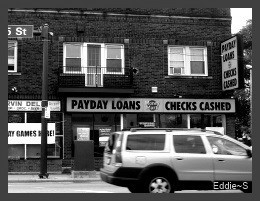Continued from part 1 & part 2
When I began lending, I enjoyed it for different reasons than I do today. This is why, in this series, I have been referring to it as a “her”, because in many ways my relationship with peer to peer lending has matured and changed since it first began. Like a crush, this avenue of online lending began as a thrill. But soon, like a romance, that thrill matured into something like deep respect and admiration, something worthy of my commitment.
Here’s how it happened.
We Need Each Other
In 2011, when I first discovered peer to peer lending, I was mostly fascinated by how it sidestepped the banks to issue loans to people who needed them. I had never seen anything like this before.
 In our national history, there has always been a gradient of richer and poorer people. There are masses of folks who need loans for a myriad of different causes. There are businesses to be funded and college tuition to be paid. There are houses which need mortgages and medical bills that need attention. The list goes on and on. In parallel, there are a lot of people with excess cash. After the essential food and housing bills are paid, millions of people in our nation have extra money that they desire to invest.
In our national history, there has always been a gradient of richer and poorer people. There are masses of folks who need loans for a myriad of different causes. There are businesses to be funded and college tuition to be paid. There are houses which need mortgages and medical bills that need attention. The list goes on and on. In parallel, there are a lot of people with excess cash. After the essential food and housing bills are paid, millions of people in our nation have extra money that they desire to invest.
So these two parties, those who need cash and those who have extra to lend out, are looking for each other. Unfortunately, the gap between these two groups of millions has been difficult to cross. The lenders need a reason to trust the borrowers and vice versa. The solution to this lack of trust was to use a financial institution, a bank that would take the cash from the investors and put it to good use while issuing the loans to people who needed them. While it was difficult for a lender to trust the average person walking down the street, a bank had some degree of credibility and history.
But this process has revealed itself to be incredibly cumbersome. Our cash flow, the national bloodstream between our lenders and the borrowers, is being choked by a series of inefficient walled systems.
Slowed from a Rush to a Trickle
The average person who wants to invest typically places their money in something like the stock market. Here the money splits: a portion goes into fees which are added to the bank’s bank account, and the rest goes into the various invested companies. The bank then has all this cash available from both these fees and from those who have purchased stock in the bank company itself. The borrowers around the country then apply to the bank for a loan.
In summary, the national bloodflow awkwardly goes from an investor through the bank to the stock market. It then flows back to the banks before finding its way to the borrower.

Each of these systems have strict checks and balances involved because so much money is at stake, especially on the borrower side of things. Additionally, each of these systems are run by very talented people who earn a generous salary, and this salary naturally comes out of the flow itself. By the time the flow connects end to end, it is a slower sadder version of how it started, like a dammed river.
The Path of Least Resistance
When I first began peer to peer lending, it was like discovering our national bloodflow had found a way around that other cumbersome system, like a river that had found its own way around a dam. It was liberation by rush of bits and bytes. People who needed cash were connecting near-seamlessly with people who had extra to spare. Platforms like Lending Club and Prosper did have their own impairing effect on the flow themselves, but it was a dramatic overall improvement.
So that is how things began for me: amazement at the model, joyful about average people getting a lower interest rate and average investors getting great returns: a system that was simpler and more efficient.
Statistics, Society, & the National Theater
This thrill began to grow and mature. I discovered that I could increase my returns if I embraced a statistical approach to this entire thing (and I love statistics). The platforms did a decent job at underwriting the people who needed a loan, but I could add to their efforts by further examining the possible candidates. And in examining these candidates I learned all sorts of things about society in general.
 For instance, people from California and Florida are statistically more likely to be irresponsible borrowers. This does not mean everybody from Florida is financially irresponsible, but it is a statistically accurate generalization. This begs a fascinating question: why are Floridians more irresponsible on Lending Club?
For instance, people from California and Florida are statistically more likely to be irresponsible borrowers. This does not mean everybody from Florida is financially irresponsible, but it is a statistically accurate generalization. This begs a fascinating question: why are Floridians more irresponsible on Lending Club?
Furthermore, I began to see a coming struggle within the powers-that-be. Lending out money to people remains one of the greatest ways that Wall Street makes its money. As peer to peer companies like Lending Club and Prosper begin to grow, as they pass $50 billion or $100 billion in total issued loans, one has to ask if the institutions on Wall Street will open their arms to accept them, or if they will be “regulated” into a less competitive corner. Fascinating.
What began with a simple curiosity and thrill has blossomed into a love of social statistics, a love of witnessing a power struggle between the internet and Wall Street, a love of helping people all around the country gain access to a lower interest rate. It is like a perfect union of technology, statistics, and morality.
A Marriage or a Fling?
I am not sure where this relationship is headed. It may be that peer to peer lending and I are simply a summer fling that will burn bright before coming to terms with reality. For now, I continue to be amazed, stunned, joyful at her existence. I am committed to her, partnered with her as we face the changes that are sure to come. Within this complexity-laden world, peer to peer lending has become a refreshing reminder that the world’s mechanism is in flux, and with each change comes an opportunity for things to get better.
[image credits: Raniel Diaz ‘Romance‘/Eddie S ‘Ohio Lottery & Payday Loans‘
Jim Pennucci ‘Aziscohos Dam‘/Sue Elias ‘Florida‘ CC-BY 2.0]

Because of the state I live in, I can not invest in Prosper or Lending Club. Are there any P2P personal loan companies in the US. Thanks
Hi Mike, once Lending Club has had it’s IPO you should have access. This should happen next year.
If truthful, your story is humbling. I cannot believe I read it. Usually, I merely read the title and turn the page to something interesting. Yet if such has been your life-story, you may already be making more than a difference.
Congrats!